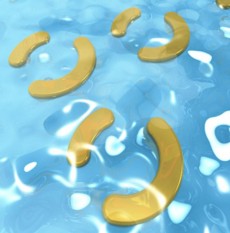Home > Press > Large-Area Low-Cost Gold Nanostructures through Colloidal Nanolithography
 |
Abstract:
Plasmonics nanostructures can generate exceptionally large optical field enhancements in cubic-nanometer volumes which can be utilized to construct highly sensitive sensors based on localized surface plasmon resonances. When designed with the appropriate geometry, metallic nanostructures exhibit narrow resonances, so called Fano resonances. These resonances can provide enhanced sensitivity which easily reach or even exceed the best known plasmonic responses of single plasmonic particles.
Large-Area Low-Cost Gold Nanostructures through Colloidal Nanolithography
Germany | Posted on September 20th, 2012One suitable geometry to generate such resonances is the asymmetric double split-ring resonator, where two curved nanostructures with different lengths are facing each other. Several examples of asymmetric split-ring resonator structures have been demonstrated with various applications including biosensors, lasing spasers, coherent plasmon emitters, and tunable metamaterials. However, the wide use of Fano sensors has been hampered by two issues: the availability of low-cost light sources, and the ability to mass-produce Fano sensors over large areas at low cost.
Jun Zhao, Harald Giessen, and coworkers (University of Stuttgart) have now developed a method to fabricate asymmetric split-ring resonators over a large area at low cost using colloidal nanolithography in combination with angled evaporation. The fabricated samples exhibit sharp and narrow optical Fano resonances in the near infrared, which are well suited for localized surface plasmon resonance refractive index sensing with atto- or zeptoliter volumes. A strong improvement of the shape and the modulation depth of the Fano resonances could be achieved through reshaping of the metal by annealing the sample at 150°C. The presented method is very flexible towards other structure geometries, scalable to even larger areas, very reproducible, and adaptable for other substrate materials and metals. This technique will pave the way towards wide utilization of plasmonic sensing applications.
The research was reported in Advanced Optical Materials, a new section in Advanced Materials dedicated to breakthrough discoveries and fundamental research in photonics, plasmonics, metamaterials, and more, covering all aspects of light-matter interactions.
####
For more information, please click here
Copyright © Wiley-VCH Materials Science Journals
If you have a comment, please Contact us.Issuers of news releases, not 7th Wave, Inc. or Nanotechnology Now, are solely responsible for the accuracy of the content.
| Related Links |
![]() Link to the original paper on Wiley Online Library:
Link to the original paper on Wiley Online Library:
![]() To get Advanced Optical Materials email alerts click here:
To get Advanced Optical Materials email alerts click here:
| Related News Press |
News and information
![]() Researchers develop molecular qubits that communicate at telecom frequencies October 3rd, 2025
Researchers develop molecular qubits that communicate at telecom frequencies October 3rd, 2025
![]() Next-generation quantum communication October 3rd, 2025
Next-generation quantum communication October 3rd, 2025
![]() "Nanoreactor" cage uses visible light for catalytic and ultra-selective cross-cycloadditions October 3rd, 2025
"Nanoreactor" cage uses visible light for catalytic and ultra-selective cross-cycloadditions October 3rd, 2025
Sensors
![]() Sensors innovations for smart lithium-based batteries: advancements, opportunities, and potential challenges August 8th, 2025
Sensors innovations for smart lithium-based batteries: advancements, opportunities, and potential challenges August 8th, 2025
![]() Quantum engineers ‘squeeze’ laser frequency combs to make more sensitive gas sensors January 17th, 2025
Quantum engineers ‘squeeze’ laser frequency combs to make more sensitive gas sensors January 17th, 2025
Discoveries
![]() Researchers develop molecular qubits that communicate at telecom frequencies October 3rd, 2025
Researchers develop molecular qubits that communicate at telecom frequencies October 3rd, 2025
![]() Next-generation quantum communication October 3rd, 2025
Next-generation quantum communication October 3rd, 2025
![]() "Nanoreactor" cage uses visible light for catalytic and ultra-selective cross-cycloadditions October 3rd, 2025
"Nanoreactor" cage uses visible light for catalytic and ultra-selective cross-cycloadditions October 3rd, 2025
Announcements
![]() Rice membrane extracts lithium from brines with greater speed, less waste October 3rd, 2025
Rice membrane extracts lithium from brines with greater speed, less waste October 3rd, 2025
![]() Researchers develop molecular qubits that communicate at telecom frequencies October 3rd, 2025
Researchers develop molecular qubits that communicate at telecom frequencies October 3rd, 2025
![]() Next-generation quantum communication October 3rd, 2025
Next-generation quantum communication October 3rd, 2025
![]() "Nanoreactor" cage uses visible light for catalytic and ultra-selective cross-cycloadditions October 3rd, 2025
"Nanoreactor" cage uses visible light for catalytic and ultra-selective cross-cycloadditions October 3rd, 2025
Printing/Lithography/Inkjet/Inks/Bio-printing/Dyes
![]() Presenting: Ultrasound-based printing of 3D materials—potentially inside the body December 8th, 2023
Presenting: Ultrasound-based printing of 3D materials—potentially inside the body December 8th, 2023
![]() Simple ballpoint pen can write custom LEDs August 11th, 2023
Simple ballpoint pen can write custom LEDs August 11th, 2023
![]() Disposable electronics on a simple sheet of paper October 7th, 2022
Disposable electronics on a simple sheet of paper October 7th, 2022
|
|
||
|
|
||
| The latest news from around the world, FREE | ||
|
|
||
|
|
||
| Premium Products | ||
|
|
||
|
Only the news you want to read!
Learn More |
||
|
|
||
|
Full-service, expert consulting
Learn More |
||
|
|
||








